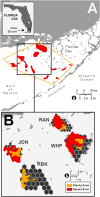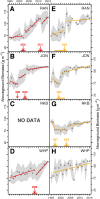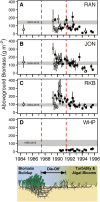Natural recovery of a marine foundation species emerges decades after landscape-scale mortality
- PMID: 33772042
- PMCID: PMC7997892
- DOI: 10.1038/s41598-021-86160-y
Natural recovery of a marine foundation species emerges decades after landscape-scale mortality
Abstract
Globally, the conditions and time scales underlying coastal ecosystem recovery following disturbance remain poorly understood, and post-disturbance examples of resilience based on long-term studies are particularly rare. Here, we documented the recovery of a marine foundation species (turtlegrass) following a hypersalinity-associated die-off in Florida Bay, USA, one of the most spatially extensive mortality events for seagrass ecosystems on record. Based upon annual sampling over two decades, foundation species recovery across the landscape was demonstrated by two ecosystem responses: the range of turtlegrass biomass met or exceeded levels present prior to the die-off, and turtlegrass regained dominance of seagrass community structure. Unlike reports for most marine taxa, recovery followed without human intervention or reduction to anthropogenic impacts. Our long-term study revealed previously uncharted resilience in subtropical seagrass landscapes but warns that future persistence of the foundation species in this iconic ecosystem will depend upon the frequency and severity of drought-associated perturbation.
Conflict of interest statement
The authors declare no competing interests.
Figures




References
-
- Dayton PK, Tegner MJ, Parnell PE, Edwards PB. Temporal and spatial patterns of disturbance and recovery in a kelp forest community. Ecol. Monogr. 1992;62:421–445. doi: 10.2307/2937118. - DOI
Publication types
MeSH terms
Substances
LinkOut - more resources
Full Text Sources
Other Literature Sources
Miscellaneous

